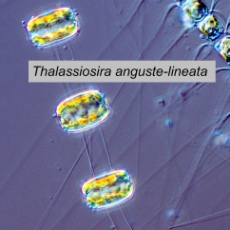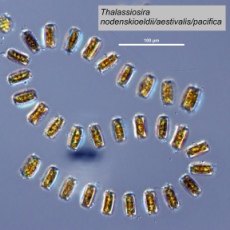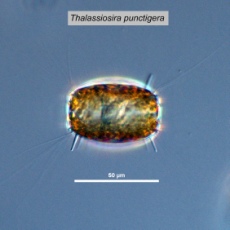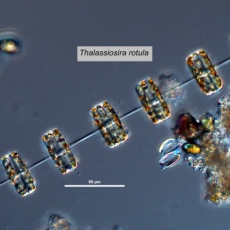
|

|
| T. anguste/lineata | T. nordenskioeldii/aestivalis/pacifica |

|

|
| T. punctigera | T. rotula |
Classification
(Guiry and Guiry 2011)
Lifestyle
Valve
In diatoms, the structurally distinct halves of the cell wall (Becker 1996).
valves (Cupp 1943).Description
Discoid
Disc-shaped.
discoid. Cells of most species are connected in flexible chains by organic threads extruded from central strutted process(es). Very few species live in groups covered in mucilage (not common around B.C.) or are solitary (T. punctigera). Strutted processes are also present on the valve CloseMargin
The outline or border that defines the shape of an organism or cell.
margins, and most species also have straight threads extending out from these CloseProcess
A natural projection or appendage on an organism.
processes (Hasle and Syvertsen 1997). The valve face is covered in CloseAreola(e)
In diatoms, the regularly repeated hexagonal holes on the valve walls (HPP 2003).
areolae or ClosePunctum
(plural: puncta) A sharp tip or small point on any part of an organism's anatomy.
puncta. Chloroplasts are numerous, small and plate-like (Cupp 1943). Cells are yellow-brown in colour.Measurements
(Hasle and Syvertsen 1997)
Key to local species
Spine
In some diatoms, "closed or solid structures projecting from the cell wall;" in dinoflagellates, solid projections that usually taper to a point.
spines on valve margins T. punctigeravalve centre usually concave T. nordenskioeldii/aestivalis/pacifica
Similar genera/species
Harmful effects
Habitat
Distribution
Environmental Ranges
Temperature range (°C): -2.045 - 29.468
Nitrate (μmol L-1): 0.053 - 34.037
Salinity: 17.940 - 37.775
Oxygen (mL L-1): 3.946 - 9.192
Phosphate (μmol L-1): 0.046 - 2.366
Close
Silicic acid
A general term to describe chemical compounds containing silicon, oxygen and hydrogen with a general formula of [SiOx(OH)4-2x]n. Diatoms polymerize silicic acid into biogenic silica to form their frustules (Azam and Chisholm 1976).
Silicate (μmol L-1): 0.648 - 125.490(OBIS 2012, cited in EOL 2012)
References
Cupp, E. E. 1943. Marine Plankton Diatoms of the West Coast of North America. University of California Press. Berkeley, California. 238.
Encyclopedia of Life (EOL). 2012. Thalassiosira. http://eol.org/pages/12082/overview. Accessed 19 Feb 2012.
Guiry, M. D. and Guiry, G. M. 2012. Thalassiosira Cleve, 1873: 6. http://www.algaebase.org/search/genus/detail/?genus_id=43768. Accessed 19 Feb 2012.
Hasle, G. R. and Syvertsen, E. E. 1997. Marine diatoms. In: Tomas, C.R. (ed.) Identifying Marine Phytoplankton. Academic Press, Inc., San Diego. 5-385.
Ocean Biogeographic Information System (OBIS). 2012. Thalassiosira. http://www.iobis.org/mapper/?taxon_id=518563. Accessed 19 Feb 2012.
